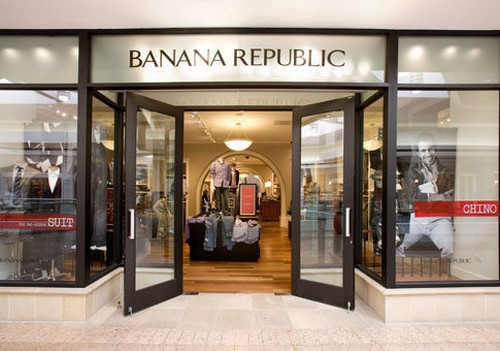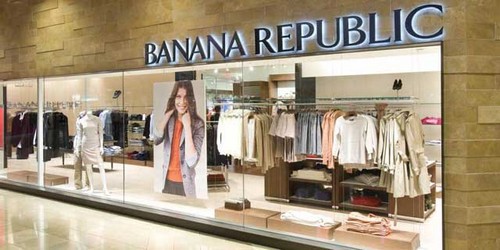The Marketing mix of Banana Republic analyses the 4Ps of Banana Republic, including the Product, Price, Place, and Promotions. Banana Republic is associated with the Lifestyle and Retail industry, specializing in apparel and accessories. It is a subsidiary of its parent company, Gap Inc.
This private company of American origin was founded in 1978 by its co-founders Patricia Ziegler and Mel Ziegler as Banana Republic Travel & Safari Company. In 1983, its parent company bought the company, and its name was changed to Banana Republic. It faces competition from the following brands.
- American Eagle Outfitters
- J CREW
- M
- Abercrombie & Fitch
- GILT Groupe
- Bonobos
- J Hilburn
About Banana Republic
- Type: Specialty retailer
- Industry: Retail
- Founded: 1978
- Founder: Mel and Patricia Ziegler
- Headquarters: San Francisco, California, United States
- Area served: Worldwide
- Key people: Sonia Syngal (Chairman) and John Mehas (CEO)
- Number of employees: 16,000
Table of Contents
Banana Republic Product Strategy
Banana Republic has been one of the prominent players in the fashion industry. It has launched several collections that express and reflect its unique style and innovative designs.
The new Product Mix of Banana Republic in 2023 is as follows (Source).
- Clothing for Men and Women: Banana Republic is renowned for its clothing range, which combines classic elements with modern designs. This includes a variety of apparel such as dresses, suits, casual wear, and more, catering to adults primarily in their 30s and 40s.
- Shoes and Accessories: Alongside clothing, the brand offers a selection of shoes and accessories. These items are designed to complement the clothing line and appeal to their target demographic of consumers seeking quality and style.
- Jewelry: As part of their accessories range, Banana Republic includes a selection of jewelry. This adds an element of sophistication to their product mix, aligning with the tastes of their customer base.
- Home Products: Expanding beyond apparel, Banana Republic delves into home products, reflecting a holistic lifestyle approach. This move indicates their intention to cater to the broader lifestyle needs of their customers.
- Baby Clothing: They have extended their product range to include baby clothing, showcasing their versatility and understanding of the evolving needs of their customer base.
Banana Republic Place Strategy
Banana Republic has spread its product presence in national and international markets. Its headquarters is in San Francisco in the United States. The company started its journey from its first store at Mill Valley in Northern California. With this, it increased its operations to include stores in nearly six hundred forty-two locations.
In the United States, the company has nearly five hundred and thirty-six stores in Puerto Rico and Manhattan. The first outlet outs of North America opened in Tokyoear 2005. CurreI outlets are Canada, Japan, Peru, Mexico, Colombia, Salvador, Costa Rica, Vietnam, Thailand, Qatar, Croatia, France, Russia, Turkey, UAE, the United Kingdom, and South Korea.
Banana Republic operates via franchise outlets and company-owned stores. It also deals with third-party website operators and company-owned websites. The company has its stores in high-profile shopping malls to garner maximum customers.
The Banana Republic launched gender-specific outlets titled Banana Republic Women and Banana Republic Men as concept stores for men and women. Its flagship outlet is more prominent than its original outlets. It features all the lines under one particular emphasis on the interiors and accessories, incorporating its distinctive and signature features like polished metal, super-sleek fixtures, and neoclassical arches.
Banana Republic’s marketing strategy focuses on accessibility and reaching its target market effectively. Here are critical vital elements of their strategy:
- Global Retail Footprint: Banana Republic operates over 600 stores in 32 countries, offering a significant physical presence in major markets worldwide. This extensive global reach ensures brand visibility and accessibility to diverse customers. Store Locations: Their stores are strategically located in malls, shopping centers, and urban areas, ensuring high visibility and foot traffic. This placement aligns with their target demographic of adults seeking quality, stylish apparel?.
- Online Store and E-Commerce: In addition to physical stores, Banana Republic has a solid online presence with an e-commerce platform. This allows customers to conveniently browse and purchase products from anywhere, catering to the growing trend of online shopping.
- Experiential Retailing: The brand has invested in creating unique in-store experiences, such as virtual reality trials, to enhance customer engagement and provide a memorable shopping experience?.
- Omnichannel Approach: Banana Republic integrates online and offline channels, providing a seamless shopping experience. This approach includes features like online wish lists and personalized recommendations based on browsing and purchase history, improving customer satisfaction and loyalty.
Banana Republic Pricing Strategy
After its acquisition by its parent company, Banana Republic was rebranded as a mainstream apparel retailer of luxurious items. Its current revenue is estimated at ten million US dollars and is the fourth highest amongst the companies and its rival brands.
The company has targeted young white-collar business professionals looking for business-friendly and sophisticated merchandise. The company emphasizes its durability and adaptability and conveys the reason for the astronomical prices.
Banana Republic uses a lifetime value pricing model and has adopted a premium pricing strategy as its products are of premium quality. It has not hesitated to maintain its premium prices.
The company faces lots of challenges from rival brands. Hence, it also maintains a competitive pricing policy by keeping its product prices at par with the prices maintained by its competitors. The brand is well-established in the market and has a following of its own; hence, it can gain success with its pricing and promotion policy.
Banana Republic’s strategy is a sophisticated blend of market positioning and customer value designed to align premium prices with its brand identity and target market. Here’s the pricing strategy:
- Premium Affordability: Banana Republic positions itself in the mid-level fashion segment. Their pricing is higher than fast fashion brands, but more affordable company labels. This strategy app is also for a broad audience seeking high-quality, stylish clothing at reasonable prices.
- Quality-Based Pricing: Emphasizing the quality and craftsmanship of their products, Banana Republic’s Republic emphasizes the use of high-quality materials and well-crafted designs. This assures customers that they are investing in durable, timeless pieces.
- Dynamic Promotional Pricing: The brand frequently employs promotional strategies like sales, discounts, and special offers. These promotions are designed to attract new customers, retain existing ones, and maintain a competitive edge in the market.
- Customer Loyalty Incentives: Banana Republic offers loyalty before rewarding customers with exclusive discounts, early access to sales, and other perks. This approach not only incentivizes repeat purchases but also enhances customer loyalty.
- Segmented Pricing Strategy: With a diverse product range, Banana Republic likely uses segmented pricing to cater to different customer segments. For instance, limited edition collections or designer collaborations might be priced higher due to their exclusivity and appeal to a more niche market.
Banana Republic Promotion Strategy
Banana Republic recognizes the power of marketing and has created ad campaigns that display society in diverse natural glory. It sells a concept of uniqueness and originality. Its ads display an urban lifestyle and relaxed image. The brand has adopted a bold marketing policy and has used advertising and marketing tools to its advantage.
The ads are shown via print, digital, electronic, and visual media in newspapers, television channels, hoardings, billboards, and mobile. Banana Republic has realized the importance of social media platforms in advertising its current surroundings. Its official website offers news and information, displays ads, relays current offerings, and showcases its products.
Today’s celebrity endorsement helps in gaining extra brand awareness. Banana Republic pointed to Olivia Palermo in 2016 as its global-style ambassador. In 2018, the brand extended its partnership with Kevin Love to include a design collaboration of accessories and apparel for women and men.
Banana Republic offers discounts and incentives to its card members as part of its promotional policy. In its factory ou let, it provides regular discounts as part of clearance sales that may vary up to 60% off, each at 9.99 dollars, an item at 7.99 dollars, or a similar sounding amount.
The brand also offers discounts of up to 40% on new arrivals to increase its customer base. On orders of 100 dollars or more, Banana Republic enables an accessible shipping facility. The company offers its customers an option of easy returns without any extra cost. The brand provides personal shopping assistants as well as the option of free alterations to attract its customers.
Some Recent Video ads and Print ads for Banana Republic are:
Liked this post? Check out the complete series on Marketing Mix

